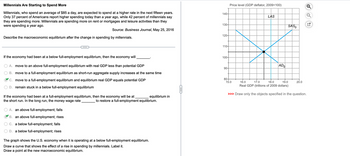
Principles of Economics 2e
2nd Edition
ISBN: 9781947172364
Author: Steven A. Greenlaw; David Shapiro
Publisher: OpenStax
expand_more
expand_more
format_list_bulleted
Question

Transcribed Image Text:Price level (GDP deflator, 2009=100)
Millennials Are Starting to Spend More
Millennials, who spend an average of $85 a day, are expected to spend at a higher rate in the next fifteen years.
Only 37 percent of Americans report higher spending today than a year ago, while 42 percent of millennials say
they are spending more. Millennials are spending more on rent or mortgages and leisure activities than they
were spending a year ago.
140-
130-
Source: Business Journal, May 25, 2016
120-
Describe the macroeconomic equilibrium after the change in spending by millennials.
If the economy had been at a below full-employment equilibrium, then the economy will
A. move to an above full-employment equilibrium with real GDP less than potential GDP
B. move to a full-employment equilibrium as short-run aggregate supply increases at the same time
'C. move to a full-employment equilibrium and equilibrium real GDP equals potential GDP
D. remain stuck in a below full-employment equilibrium
If the economy had been at a full-employment equilibrium, then the economy will be at
the short run. In the long run, the money wage rate
A. an above full-employment; falls
B. an above full-employment; rises
C. a below full-employment; falls
D. a below full-employment; rises
equilibrium in
to restore a full-employment equilibrium.
The graph shows the U.S. economy when it is operating at a below full-employment equilibrium.
Draw a curve that shows the effect of a rise in spending by millennials. Label it.
Draw a point at the new macroeconomic equilibrium.
110-
100-
90-
80+
15.0
16.0
17.0
LAS
SASO
18.0
ADO
ㅇ 선
19.0
20.0
Real GDP (trillions of 2009 dollars)
>>> Draw only the objects specified in the question.
Expert Solution
This question has been solved!
Explore an expertly crafted, step-by-step solution for a thorough understanding of key concepts.
Step by stepSolved in 2 steps

Knowledge Booster
Similar questions
- Last year, a small nation with abundant forests cut down 200 worth of trees. It then turned 100 worth of trees into 150 worth of lumber. It used 100 worth of that lumber to produce $250 worth of bookshelves. Assuming the country produces no other outputs, and there are no other inputs used in producing trees, lumber, and bookshelves, what is this nations GDP? In other words, what is the value of the final goods the nation produced including trees, lumber and bookshelves?arrow_forwardWhat are the two main difficulties that arise in comparing different comparing GDP?arrow_forwardShould people typically pay more attention to their real income or their nominal income? If you Choose the latter, why would that make sense in todays world? Would your answer he the same for the 1970s?arrow_forward
- How might you measure a green GDP?arrow_forwardU.S. macroeconomic data are among the best in the world. Given what you learned in the Clear It Up 'How do statisticians measure GDP?', does this surprise you, or does this simply reflect the complexity of a modern economy?arrow_forwardWhat are the main components of measuring GDP with what is produced?arrow_forward
- What does GDP not tell us about the economy?arrow_forwardWhat is potential GDP?arrow_forwardEthiopia has a GDP of 8 billion (measured in U.S. dollars) and a population of 55 million. Costa Rica has a GDP of 9 billion (measured in U.S. dollars) and a population of 4 million. Calculate the per capita GDP for each country and identify which one is higher.arrow_forward
- Why do you think that GDP does not grow at a steady rate, but rather speeds up and slows down?arrow_forwardWhy is the GDP deflator not an accurate measure of inflation as it impacts a household?arrow_forwardList some of the reasons why economists should not consider GDP an effective measure of the standard of living in a county.arrow_forward
arrow_back_ios
SEE MORE QUESTIONS
arrow_forward_ios
Recommended textbooks for you
 Principles of Economics 2eEconomicsISBN:9781947172364Author:Steven A. Greenlaw; David ShapiroPublisher:OpenStax
Principles of Economics 2eEconomicsISBN:9781947172364Author:Steven A. Greenlaw; David ShapiroPublisher:OpenStax Essentials of Economics (MindTap Course List)EconomicsISBN:9781337091992Author:N. Gregory MankiwPublisher:Cengage Learning
Essentials of Economics (MindTap Course List)EconomicsISBN:9781337091992Author:N. Gregory MankiwPublisher:Cengage Learning Brief Principles of Macroeconomics (MindTap Cours...EconomicsISBN:9781337091985Author:N. Gregory MankiwPublisher:Cengage Learning
Brief Principles of Macroeconomics (MindTap Cours...EconomicsISBN:9781337091985Author:N. Gregory MankiwPublisher:Cengage Learning Principles of Economics (MindTap Course List)EconomicsISBN:9781305585126Author:N. Gregory MankiwPublisher:Cengage Learning
Principles of Economics (MindTap Course List)EconomicsISBN:9781305585126Author:N. Gregory MankiwPublisher:Cengage Learning Principles of Macroeconomics (MindTap Course List)EconomicsISBN:9781285165912Author:N. Gregory MankiwPublisher:Cengage Learning
Principles of Macroeconomics (MindTap Course List)EconomicsISBN:9781285165912Author:N. Gregory MankiwPublisher:Cengage Learning Principles of Economics, 7th Edition (MindTap Cou...EconomicsISBN:9781285165875Author:N. Gregory MankiwPublisher:Cengage Learning
Principles of Economics, 7th Edition (MindTap Cou...EconomicsISBN:9781285165875Author:N. Gregory MankiwPublisher:Cengage Learning

Principles of Economics 2e
Economics
ISBN:9781947172364
Author:Steven A. Greenlaw; David Shapiro
Publisher:OpenStax

Essentials of Economics (MindTap Course List)
Economics
ISBN:9781337091992
Author:N. Gregory Mankiw
Publisher:Cengage Learning

Brief Principles of Macroeconomics (MindTap Cours...
Economics
ISBN:9781337091985
Author:N. Gregory Mankiw
Publisher:Cengage Learning

Principles of Economics (MindTap Course List)
Economics
ISBN:9781305585126
Author:N. Gregory Mankiw
Publisher:Cengage Learning

Principles of Macroeconomics (MindTap Course List)
Economics
ISBN:9781285165912
Author:N. Gregory Mankiw
Publisher:Cengage Learning

Principles of Economics, 7th Edition (MindTap Cou...
Economics
ISBN:9781285165875
Author:N. Gregory Mankiw
Publisher:Cengage Learning